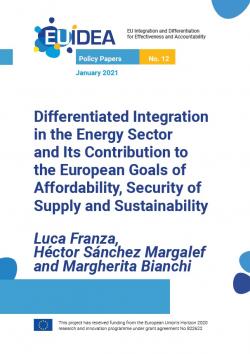Differentiated Integration in the Energy Sector and Its Contribution to the European Goals of Affordability, Security of Supply and Sustainability
This policy paper studies the role of differentiated integration in the field of energy – where an EU-level compromise is not always reachable due to strong heterogeneity among member states. The paper starts with an analysis of how differentiated integration in energy has been evolving, in order to take stock of main trends and emerging challenges. The empirical part builds on an analysis of three case studies of differentiated integration – the Energy Community, the Pentalateral Energy Forum and the Covenant of Mayors. These institutions have been selected because they diverge along several lines (e.g., rationale for promoting differentiated integration, objectives, composition, regulatory features, organisational features), allowing for a relevant comparative evaluation of their effectiveness in boosting integration. Even if all the differentiated integration institutions have limitations of some sort, the findings mostly point to three success stories, which helped advance EU integration and reach the three key objectives of EU policy-making in energy: affordability, security of supply and sustainability.
-
Details
Rome, IAI, January 2021, 20 p. -
In:
-
Issue
Policy Paper 12
Executive summary
Introduction
1. Key themes in European integration in the areas of energy and climate
2. The Energy Community
2.1 Objectives and composition
2.2 Regulatory dimension
2.3 Organisational dimension
2.4 How effective has the Energy Community been?
3. The Pentalateral Energy Forum
3.1 Objectives and composition
3.2 Regulatory and organisational dimension
3.3 How effective has the PEF been?
4. The Covenant of Mayors
4.1 Objectives and composition
4.2 Regulatory dimension
4.3 Organisational dimension
4.4 How effective has the Covenant of Mayors been?
Conclusions
References



